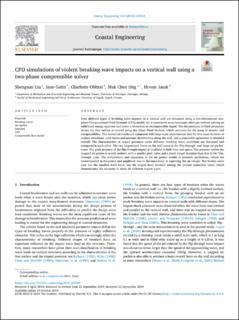| dc.contributor.author | Liu, Shengnan | |
| dc.contributor.author | Gatin, Inno | |
| dc.contributor.author | Obhrai, Charlotte | |
| dc.contributor.author | Ong, Muk Chen | |
| dc.contributor.author | Jasak, Hrvoje | |
| dc.date.accessioned | 2023-02-01T13:11:27Z | |
| dc.date.available | 2023-02-01T13:11:27Z | |
| dc.date.created | 2019-11-28T14:40:25Z | |
| dc.date.issued | 2019 | |
| dc.identifier.citation | Liu, S., Gatin, I., Obhrai, C., Ong, M. C., & Jasak, H. (2019). CFD simulations of violent breaking wave impacts on a vertical wall using a two-phase compressible solver. Coastal Engineering, 154, 103564. | en_US |
| dc.identifier.issn | 0378-3839 | |
| dc.identifier.uri | https://hdl.handle.net/11250/3047747 | |
| dc.description.abstract | Four different types of breaking wave impacts on a vertical wall are simulated using a two-dimensional two-phase Computational Fluid Dynamic (CFD) model. Air is considered as an isentropic ideal gas without solving an additional energy equation and water is treated as an incompressible liquid. The discontinuity in fluid properties across the free surface is treated using the Ghost Fluid Method, which accounts for the jump in density and compressibility. The numerical results are compared with large-scale experimental data for five cases in terms of surface elevations, total forces and pressure distributions along the wall, and a reasonable agreement is obtained overall. The characteristics of impact pressures under different breaking wave conditions are discussed and compared to each other. The two largest total forces on the wall occur in the ‘flip-through’ and ‘large air pocket’ cases. The peak pressure of the flip-through impact is localized in both time and space. The pressure within the trapped air pocket is nearly uniform with a smaller peak value and a much longer duration than that of the ‘flip-through’ case. The compression and expansion of the air pocket results in pressure oscillations, which are overestimated in frequency and amplitude due to the inaccuracy in capturing the air escape. The broken wave case has the smallest total force, but the largest local pressure among the present numerical cases, which demonstrates the necessity to study all different impact types. | en_US |
| dc.language.iso | eng | en_US |
| dc.publisher | Elsevier | en_US |
| dc.rights | Navngivelse 4.0 Internasjonal | * |
| dc.rights.uri | http://creativecommons.org/licenses/by/4.0/deed.no | * |
| dc.title | CFD simulations of violent breaking wave impacts on a vertical wall using a two-phase compressible solver | en_US |
| dc.type | Peer reviewed | en_US |
| dc.type | Journal article | en_US |
| dc.description.version | publishedVersion | en_US |
| dc.rights.holder | The authors | en_US |
| dc.subject.nsi | VDP::Teknologi: 500 | en_US |
| dc.source.pagenumber | 1-22 | en_US |
| dc.source.volume | 154 | en_US |
| dc.source.journal | Coastal Engineering | en_US |
| dc.identifier.doi | 10.1016/j.coastaleng.2019.103564 | |
| dc.identifier.cristin | 1753908 | |
| dc.relation.project | Notur/NorStore: NN9372K | en_US |
| cristin.ispublished | true | |
| cristin.fulltext | original | |
| cristin.qualitycode | 2 | |

